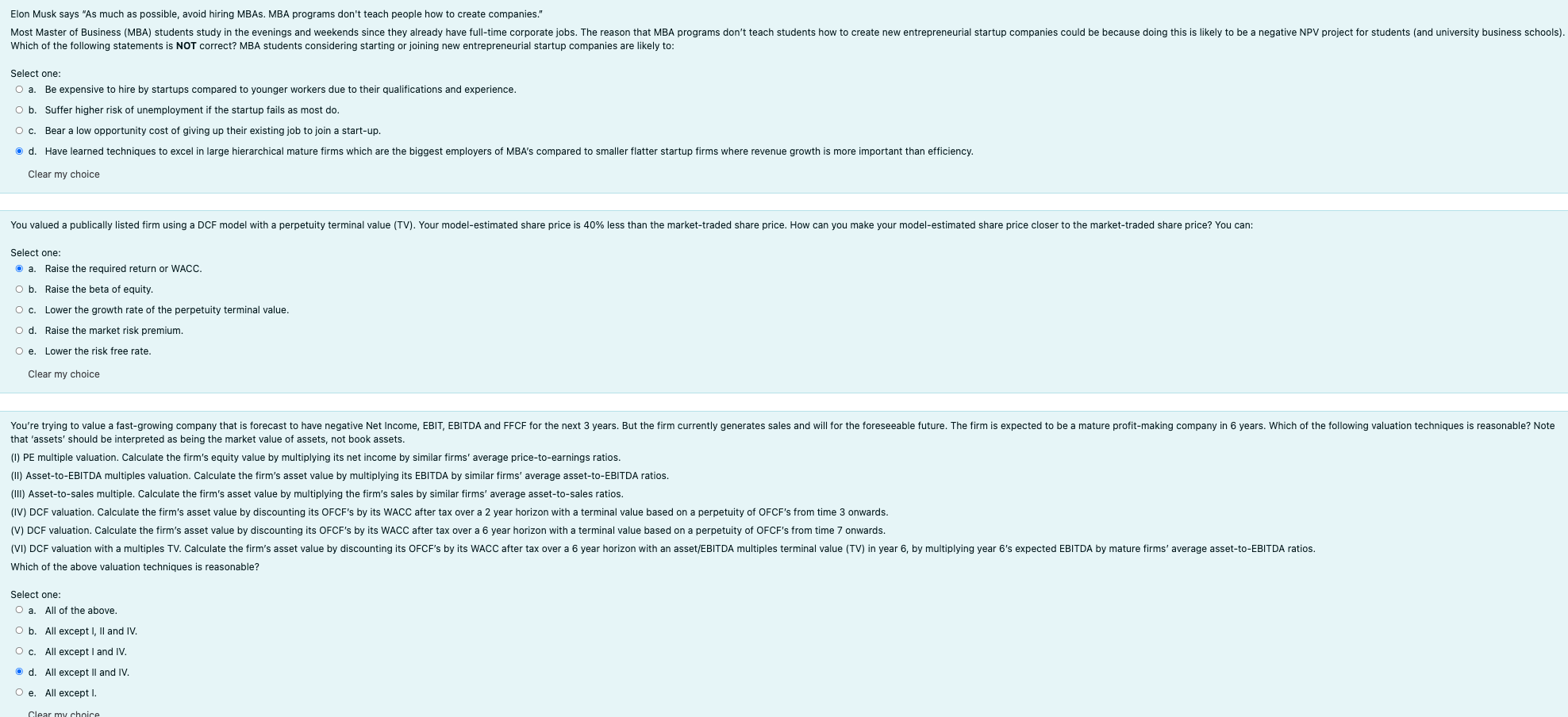
Elon Musk says "As much as possible, avoid hiring MBAs. MBA programs don't teach people how to create companies." Most Master of Business (MBA) students study in the evenings and weekends since they already have full-time corporate jobs. The reason that MBA programs don't teach students how to create new entrepreneurial startup companies could be because doing this is likely to be a negative NPV project for students and university business schools). Which of the following statements is NOT correct? MBA students considering starting or joining new entrepreneurial startup companies are likely to: Select one: O a. Be expensive to hire by startups compared to younger workers due to their qualifications and experience. O b. Suffer higher risk of unemployment if the startup fails as most do. O C. Bear a low opportunity cost of giving up their existing job to join a start-up. od. Have learned techniques to excel in large hierarchical mature firms which are the biggest employers of MBA's compared to smaller flatter startup firms where revenue growth is more important than efficiency. Clear my choice You valued a publically listed firm using a DCF model with a perpetuity terminal value (TV). Your model-estimated share price is 40% less than the market-traded share price. How can you make your model-estimated share price closer to the market-traded share price? You can: Select one: a. Raise the required return or WACC. O b. Raise the beta of equity. OC. Lower the growth rate of the perpetuity terminal value. O d. Raise the market risk premium. O e. Lower the risk free rate. Clear my choice You're trying to value a fast-growing company that is forecast to have negative Net Income, EBIT, EBITDA and FFCF for the next 3 years. But the firm currently generates sales and will for the foreseeable future. The firm is expected to be a mature profit-making company in 6 years. Which of the following valuation techniques is reasonable? Note that 'assets' should be interpreted as being the market value of assets, not book assets. (1) PE multiple valuation. Calculate the firm's equity value by multiplying its net income by similar firms' average price-to-earnings ratios. (II) Asset-to-EBITDA multiples valuation. Calculate the firm's asset value by multiplying its EBITDA by similar firms' average asset-to-EBITDA ratios. (III) Asset-to-sales multiple. Calculate the firm's asset value by multiplying the firm's sales by similar firms' average asset-to-sales ratios. (IV) DCF valuation. Calculate the firm's asset value by discounting its OFCF's by its WACC after tax over a 2 year horizon with a terminal value based on a perpetuity of OFCF's from time 3 onwards. (V) DCF valuation. Calculate the firm's asset value by discounting its OFCF's by its WACC after tax over a 6 year horizon with a terminal value based on a perpetuity of OFCF's from time 7 onwards. (VI) DCF valuation with a multiples TV. Calculate the firm's asset value by discounting its OFCF's by its WACC after tax over a 6 year horizon with an asset/EBITDA multiples terminal value (TV) in year 6, by multiplying year 6's expected EBITDA by mature firms' average asset-to-EBITDA ratios. Which of the above valuation techniques is reasonable? Select one: O a. All of the above. O b. All except I, II and IV. O c. All except I and IV. d. All except II and IV. Oe. All except I. Clear my choice Elon Musk says "As much as possible, avoid hiring MBAs. MBA programs don't teach people how to create companies." Most Master of Business (MBA) students study in the evenings and weekends since they already have full-time corporate jobs. The reason that MBA programs don't teach students how to create new entrepreneurial startup companies could be because doing this is likely to be a negative NPV project for students and university business schools). Which of the following statements is NOT correct? MBA students considering starting or joining new entrepreneurial startup companies are likely to: Select one: O a. Be expensive to hire by startups compared to younger workers due to their qualifications and experience. O b. Suffer higher risk of unemployment if the startup fails as most do. O C. Bear a low opportunity cost of giving up their existing job to join a start-up. od. Have learned techniques to excel in large hierarchical mature firms which are the biggest employers of MBA's compared to smaller flatter startup firms where revenue growth is more important than efficiency. Clear my choice You valued a publically listed firm using a DCF model with a perpetuity terminal value (TV). Your model-estimated share price is 40% less than the market-traded share price. How can you make your model-estimated share price closer to the market-traded share price? You can: Select one: a. Raise the required return or WACC. O b. Raise the beta of equity. OC. Lower the growth rate of the perpetuity terminal value. O d. Raise the market risk premium. O e. Lower the risk free rate. Clear my choice You're trying to value a fast-growing company that is forecast to have negative Net Income, EBIT, EBITDA and FFCF for the next 3 years. But the firm currently generates sales and will for the foreseeable future. The firm is expected to be a mature profit-making company in 6 years. Which of the following valuation techniques is reasonable? Note that 'assets' should be interpreted as being the market value of assets, not book assets. (1) PE multiple valuation. Calculate the firm's equity value by multiplying its net income by similar firms' average price-to-earnings ratios. (II) Asset-to-EBITDA multiples valuation. Calculate the firm's asset value by multiplying its EBITDA by similar firms' average asset-to-EBITDA ratios. (III) Asset-to-sales multiple. Calculate the firm's asset value by multiplying the firm's sales by similar firms' average asset-to-sales ratios. (IV) DCF valuation. Calculate the firm's asset value by discounting its OFCF's by its WACC after tax over a 2 year horizon with a terminal value based on a perpetuity of OFCF's from time 3 onwards. (V) DCF valuation. Calculate the firm's asset value by discounting its OFCF's by its WACC after tax over a 6 year horizon with a terminal value based on a perpetuity of OFCF's from time 7 onwards. (VI) DCF valuation with a multiples TV. Calculate the firm's asset value by discounting its OFCF's by its WACC after tax over a 6 year horizon with an asset/EBITDA multiples terminal value (TV) in year 6, by multiplying year 6's expected EBITDA by mature firms' average asset-to-EBITDA ratios. Which of the above valuation techniques is reasonable? Select one: O a. All of the above. O b. All except I, II and IV. O c. All except I and IV. d. All except II and IV. Oe. All except I. Clear my choice







